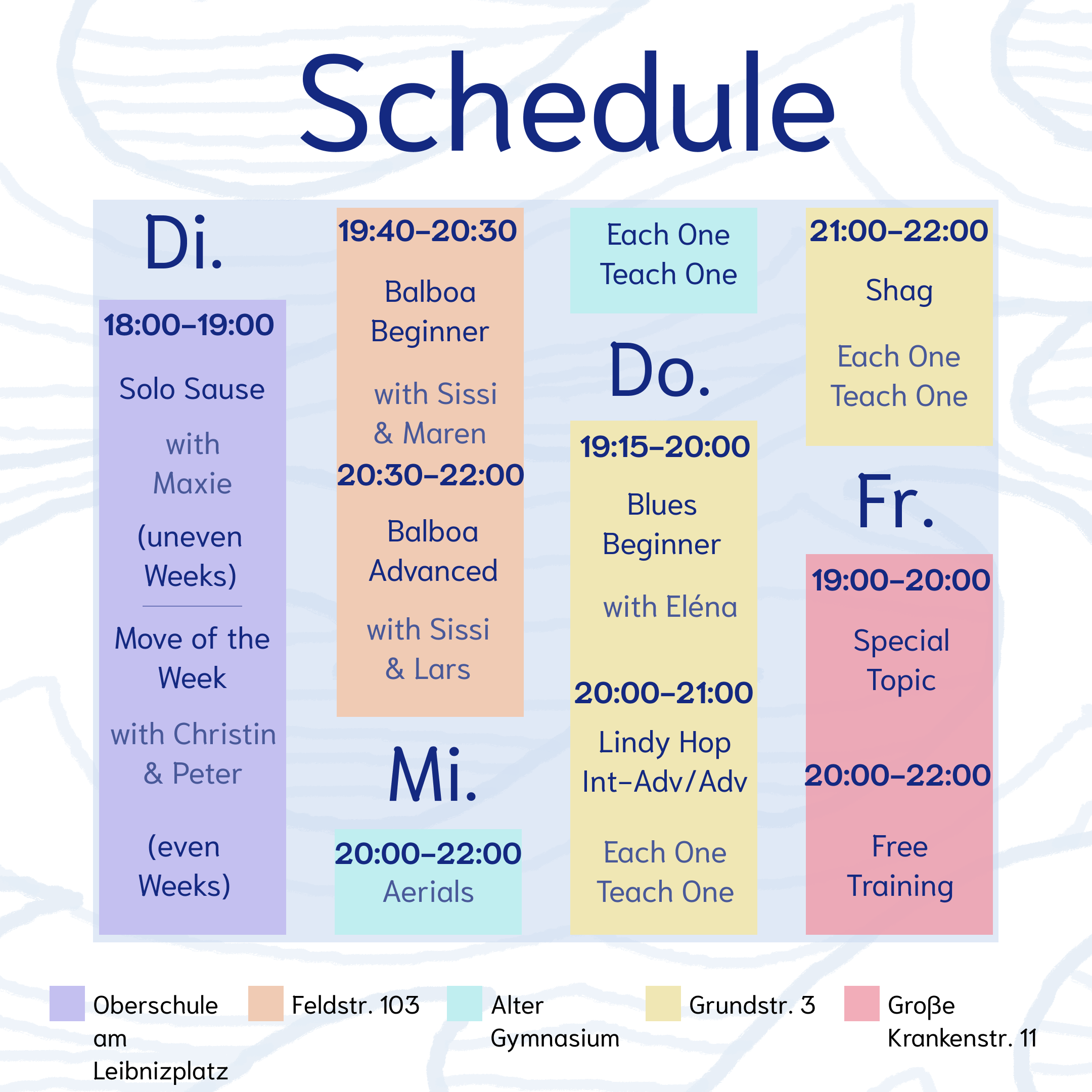Picture by Gjon Mili for LIFE, with Willa Mae Ricker & Leon James. 23rd of August 1943
Classes offered
We are a self-organized group. This means that our entire course offering is given without professional guidance and the group basically supports and trains itself.

Solo Sause
with Maxie
Solo-Sause with Maxie // A colorful mix of solo jazz (routines), improvisation, hip hop and freestyle – we focus on the fun!
The class is open to all levels, but previous solo jazz experience is helpful. Just come and try it out!
We will start with the Caribbean Shim Sham ->
WHERE? Oberschule am Leibnitzplatz, access through the inner courtyard, Friedrich- Ebert- Straße, Upper Hall.
WHEN? Tuesdays from 18:00 to 19:00, alternating fortnightly with Move of the Week.
What is Solo Jazz?
Harri Heinilla, in his article What is Authentic Jazz, says the following:
“Here are some important features found in Authentic Jazz Dance:
The most important part of Authentic Jazz Dance is individuality. Each Jazz dancer is different. You should not copy anybody else exactly.
Rhythm is essential in Authentic Jazz Dance. For example, Pepsi Bethel has said: Without rhythm it is nothing. The rhythm is more important than movements you do. There is no definite way to do movements in Authentic Jazz Dance but the rhythm has to be consistent.
Everything should be done by music in Jazz dancing. When you are listening to music and Jazz dancing, you have a dialogue with music. You communicate with music and be a part of the orchestra as an instrument as for example Mura Dehn* has explained in her Spirit Moves documentary.
That is Authentic Jazz Dance.”
*Mura Dehn is a complex, controversial figure.
In Mabel Lee’s Performance von Chicken Shack Shuffle, we can very well recognize a few “classic” solo jazz steps, including: Fish Tails, Fall of the Log, Kick Ball Change, Tabby the Cat, etc….
In this video today Helena Kanini Kiiru dances many of the same steps shown above, in her very own way.
Lindy Hop
-Each One Teach One
In this class we show each other new steps/rhythms/figures that we have learned over time and would like to share with the community. Each person who signs up for this class agrees to take over a one hour class to show something.
WO? Studio Anne Hoff, Grundstraße 4
WANN? Thursday from 20:00 to 21:00
LEVEL? Intermediate-Advanced/ Advanced
-Christin & Peter
We focus on the connection in the dancing couple and on staying open for unexpected turns. Let us surprise you! We are looking forward to meeting you!
WO? Oberschule am Leibnitzplatz, access through the inner courtyard, Friedrich- Ebert- Straße, Upper Hall.
WANN? Tuesdays from 18:00 to 19:00, alternating fortnightly with Solo Sause.
LEVEL? Intermediate-Advanced/ Advanced
Was ist Lindy Hop?
The online platform iLindy gave a brief yet detailed description of Lindy Hop on its Instagram:
“Lindy Hop is a black American dance that originated in Harlem, New York City, in the late 1920s. It was danced mainly in large ballrooms, such as the Savoy Ballroom in NYC and evolved alongside the popular music of the day played by Black Big Bands.
The dance developed from a combination of earlier dances such as the Charleston, the Breakaway, the Texas Tommy, and the Cake Walk. All of these dances were danced to early jazz music.
Each one of these dances has deep roots in West African dance, music, culture* and therefore share the common Black American social dance values, such as individuality, spontaneity, rhythm, and improvisation.”
*There are also influences from European dances in Lindy Hop and in jazz dance in general (such as Bohemian Polka or Irish Tap Dance). However, the West African influence is FAR more prominent.
This is what Lindy Hop can look like today 🙂 With LaTasha Barnes and Peter Strom.
In this video you can see some dancers of the First Generation of Lindy Hoppers. The dancers here are Mattie Purnell and Shorty George Snowden. More info can be read in the description of the video.
The Second Generation is represented primarily by Whitey’s Lindy Hoppers and their incredible Air Steps*. Here you can see Norma Miller, Leon James, Troy Brown, Dorothy Miller, Johnny Smalls, Snooky Beasley, Willa Mae Ricker, Ella Gibson, and George Greenidge.
*The Air Steps were invented by Frankie Manning. He is not seen on this video.
The Third Generation is often overshadowed by the false narrative of the “revival.”
Among the most important dancers are: “Big Nick” Nicholson, Teddy Brown, George and “Sugar” Sullivan, Barbara Billups and “Mama Lou” Parks.
Workshops
There are no workshops offered at the moment.
Socials & Partys
You can find all the informatin you need in our calendar about parties and socials in Bremen and its surrounding areas.
Library
We have a bookseller in our Lindy Hop Community, Michael, who has dedicated a space especially for us in his bookstore. Here you can find everything about Blues, Lindy Hop, music and dance as well as Black American culture. There’s also a coffee to go with it. 🙂
Our List as of right now:
– Stomping the Blues, Albert Murray
– The Secret Language of the Blues. What the Lyrics really mean, Robert Cremer
– Jookin’: The rise of social dance formations in African-American culture, Katrina Hazzard-Gordon
– Go Tell it on the Mountain, James Baldwin
– The Bluest Eye, Toni Morrison
– Modern Moves: Dancing Race During the Ragtime and Jazz Eras, Danielle Robinson
